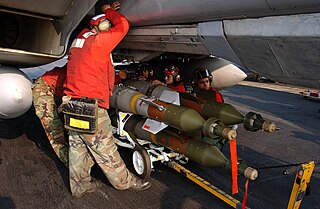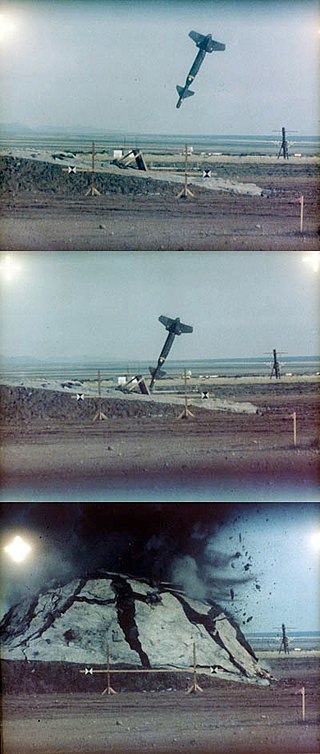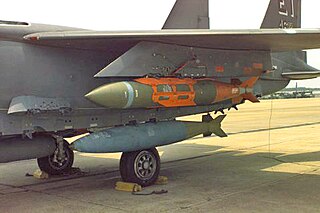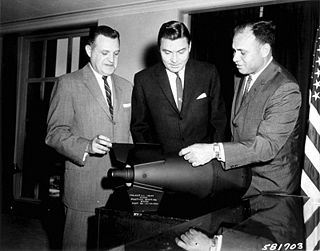A bunker buster is a type of munition that is designed to penetrate hardened targets or targets buried deep underground, such as military bunkers.

The GBU-12 Paveway II is an American aerial laser-guided bomb, based on the Mk 82 500-pound (227 kg) general-purpose bomb, but with the addition of a nose-mounted laser seeker and fins for guidance. A member of the Paveway series of weapons, Paveway II entered into service c. 1976. It is currently in service with the U.S. Air Force, U.S. Navy, U.S. Marine Corps, and various other air forces.
The GBU-28 is a 5,000-pound (2,268 kg) class laser-guided "bunker busting" bomb produced originally by the Watervliet Arsenal, Watervliet, New York. It was designed, manufactured, and deployed in less than three weeks due to an urgent need during Operation Desert Storm to penetrate hardened Iraqi command centers located deep underground. Only two of the weapons were dropped in Desert Storm, both by F-111Fs. One GBU-28 was dropped during Operation Iraqi Freedom, and some reportedly during the 2021 Israel–Palestine crisis.
The Mark 84 or BLU-117 is a 2,000 pound American general-purpose bomb. It is the largest of the Mark 80 series of weapons. Entering service during the Vietnam War, it became a commonly used US heavy unguided bomb to be dropped. At the time, it was the third largest bomb by weight in the US inventory behind the 15,000-pound (6,800 kg) BLU-82 "Daisy Cutter" and the 3,000-pound (1,400 kg) M118 "demolition" bomb. It is currently sixth in size due to the addition of the 5,000 lb (2,300 kg) GBU-28 in 1991, the 22,600 lb (10,300 kg) GBU-43/B Massive Ordnance Air Blast bomb (MOAB) in 2003, and the 30,000 lb (14,000 kg) Massive Ordnance Penetrator.

GBU-24 Paveway III or simply GBU-24 is a family of laser-guided bombs, a sub-group of the larger Raytheon Paveway III family of weapons. The Paveway guidance package consists of a seeker package attached to the nose of the weapon, and a wing kit attached to the rear to provide stability and greater range.
The Mark 82 is a 500 pound unguided, low-drag general-purpose bomb, part of the United States Mark 80 series. The explosive filling is usually tritonal, though other compositions have sometimes been used.
The Joint Direct Attack Munition (JDAM) is a guidance kit that converts unguided bombs, or "dumb bombs", into all-weather precision-guided munitions. JDAM-equipped bombs are guided by an integrated inertial guidance system coupled to a Global Positioning System (GPS) receiver, giving them a published range of up to 15 nautical miles (28 km). JDAM-equipped bombs range from 500 to 2,000 pounds. The JDAM's guidance system was jointly developed by the United States Air Force and United States Navy, hence the "joint" in JDAM. When installed on a bomb, the JDAM kit is given a GBU identifier, superseding the Mark 80 or BLU nomenclature of the bomb to which it is attached.

Paveway is a series of laser-guided bombs (LGBs).

A general-purpose bomb is an air-dropped bomb intended as a compromise between blast damage, penetration, and fragmentation in explosive effect. They are designed to be effective against enemy troops, vehicles, and buildings.

The M117 is an air-dropped demolition bomb used by United States military forces. The weapon dates back to the Korean War of the early 1950s. Although it has a nominal weight of 750 pounds (340 kg) its actual weight, depending on fuze and retardation options, can be around 820 pounds (372 kg). The bomb's explosive content is typically 386 pounds (175 kg) of Tritonal or 377 pounds (171 kg) of Minol in the case of the M117A1E2 due to their higher density and detonation velocity compared to TNT. Demolition bombs rely on time delayed fuzes which allow the bomb to burrow into a building or other structure before detonating. The M117 can be configured with a conical low-drag tail for medium and high altitude deliveries or a high-drag tail fin for low-altitude drops, delaying the bombs hitting their targets ensuring bombers are out of the blast zone before detonation. The M117 was the basis for the BOLT-117, the world's first laser-guided bomb.

The Mark 81 is a general-purpose 250-pound (110 kg) bomb. It's the smallest of the Mark 80 series of low-drag general-purpose bombs.

The BLU-109/B is a hardened penetration bomb used by the United States Air Force. As with other "bunker busters", it is intended to penetrate concrete shelters and other hardened structures before exploding. In addition to the US, it is part of the armament of the air forces of Australia, Belgium, Canada, Denmark, France, Germany, Greece, Italy, Israel, Netherlands, Norway, Pakistan, Saudi Arabia, United Kingdom and United Arab Emirates.

The W54 was a tactical nuclear warhead developed by the United States in the late 1950s. The weapon is notable for being the smallest nuclear weapon in both weight and yield to have entered US service. It was a compact implosion device containing plutonium-239 as its fissile material, and in its various versions and mods it had a yield of 10 to 1,000 tons of TNT.

The GBU-57A/BMassive Ordnance Penetrator (MOP) is a precision-guided, 30,000-pound (14,000 kg) "bunker buster" bomb used by the United States Air Force. This is substantially larger than the deepest-penetrating bunker busters previously available, the 5,000-pound (2,300 kg) GBU-28 and GBU-37.

The "SPICE" is an Israeli-developed, EO/GPS- guidance kit used for converting air-droppable unguided bombs into precision-guided bombs.

A guided bomb is a precision-guided munition designed to achieve a smaller circular error probable (CEP).

The Mark 39 nuclear bomb and W39 nuclear warhead were versions of an American thermonuclear weapon, which were in service from 1957 to 1966.
The H-4 SOW is a precision-guided glide bomb manufactured by NESCOM and deployed by the Pakistan Air Force, capable of striking targets at stand-off range. It has a terminal guidance system based on an infrared homing seeker, which identifies the target during the final stage of flight. Designed to hit targets out to 120 km, the bomb may have the capability to evade radar.

A precision-guided munition is a guided munition intended to precisely hit a specific target, to minimize collateral damage and increase lethality against intended targets. During the First Gulf War guided munitions accounted for only 9% of weapons fired, but accounted for 75% of all successful hits. Despite guided weapons generally being used on more difficult targets, they were still 35 times more likely to destroy their targets per weapon dropped.

The GBU-39/B Small Diameter Bomb (SDB) is a 250-pound (110 kg) precision-guided glide bomb that is intended to provide aircraft with the ability to carry a higher number of more accurate bombs. Most US Air Force aircraft will be able to carry a pack of four SDBs in place of a single 2,000-pound (910 kg) bomb. It first entered service in 2006. The Ground Launched Small Diameter Bomb (GLSDB) was later developed to enable the SDB to be launched from a variety of ground launchers and configurations.















